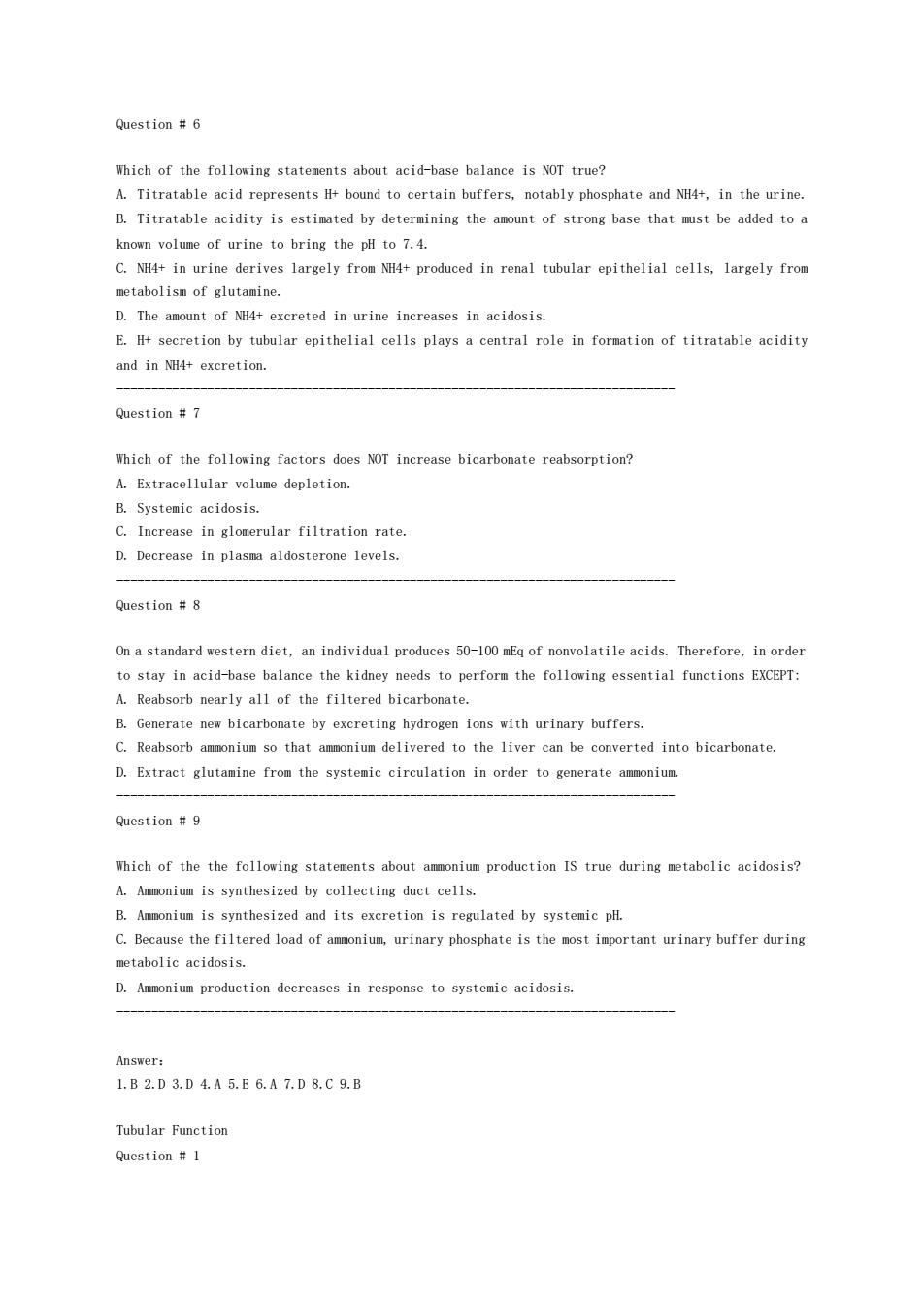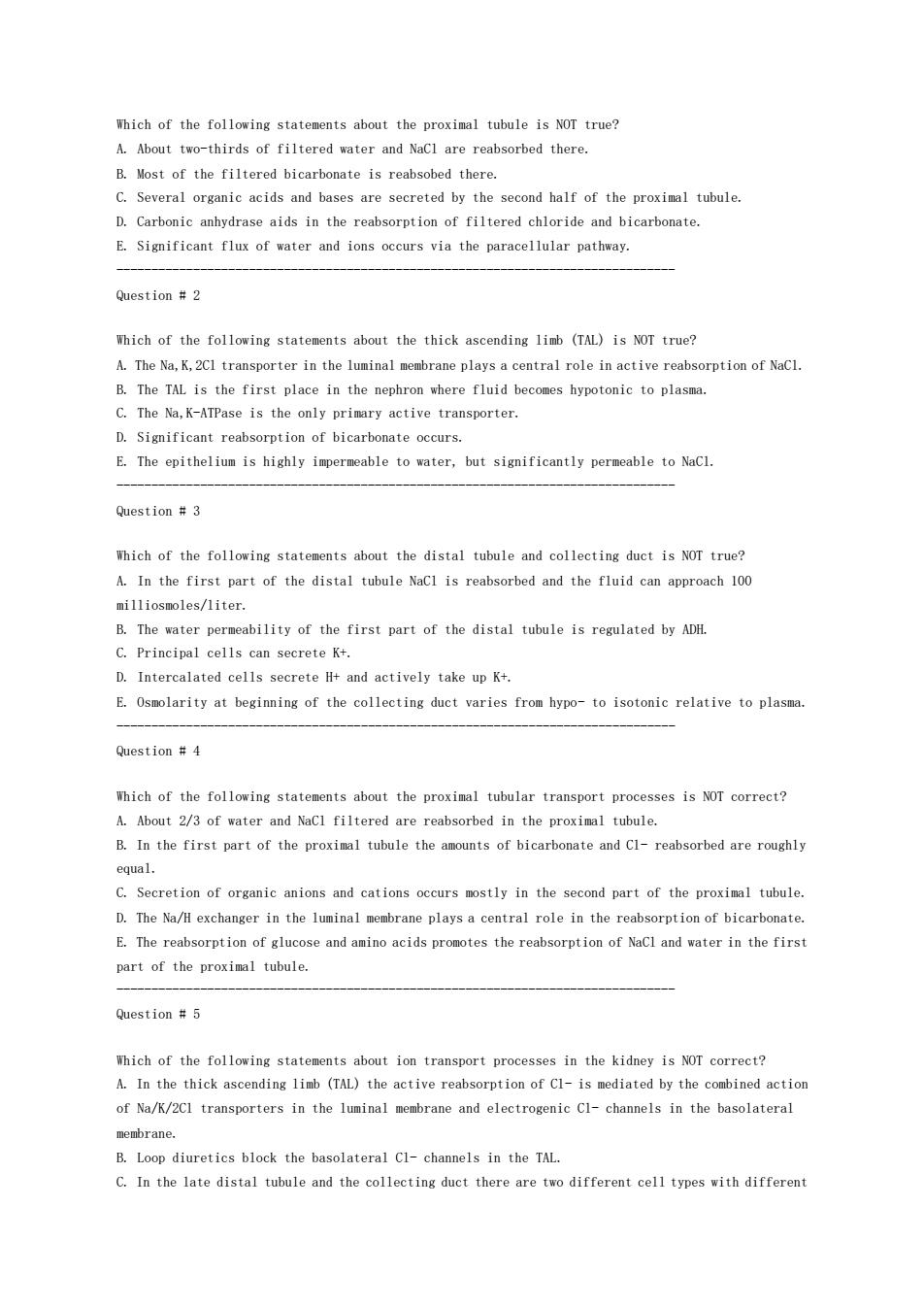
Question#6 Which of the following statenents about acid-base balance is nor true? A Titratable acid rep to certain buffers,notably phosphate and N4 in the B.Titratable acidity is estimted by determining the amount of strong base that mst be added toa known volune of urine to bring the pli to 7.4. C.NH4+in urine derives largely from NH4+produced in renal tubular epithelial cells,largely from motabolisn of olutamine D.The amount of NH4+excreted in urine increases in acidosis. E secretion by tubular epithelial cells plays a central role in foreation of titratable acidity and in NH4+excretion. Question 7 Which of the following factors does NOT increase bicarbonate reabsorption? B.Systemic acidosis. C.Increase in glomerular filtration rate. D.Decrease in plasma aldosterone levels. On astandard western diet,an individual produces 50-100of nonvolatile acids.Therefore,inorde to stay in acid-base balance the kidney needs to perform the following essential functions EXCEPT: A.Reabsorb nearly all of the filtered bicarbonate. B.Generate new bicarbonate by excreting hydrogen ions with urinary buffers. C.Reabsorb ammonium so that amonium delivered to the liver can be converted into bicarbonate D.Extract glutamine from the systemic circulation in order to generate amonius Question #9 Which of the the following statements about ammonium production IS true during metabolic acidosis? A.Anmoniun is synthesized by collecting duct cells. BAmonium is synthesized and its excretion is regulated by systemic C.Because the filtered load phosphate is the ost important urinary buffer during metabolic acidosis D.Ammoniun production decreases in response to systemic acidosis. n B2.D3.D4.A5.E6.A7.D8.C9. Tubular Function Question 1
Question # 6 Which of the following statements about acid-base balance is NOT true? A. Titratable acid represents H+ bound to certain buffers, notably phosphate and NH4+, in the urine. B. Titratable acidity is estimated by determining the amount of strong base that must be added to a known volume of urine to bring the pH to 7.4. C. NH4+ in urine derives largely from NH4+ produced in renal tubular epithelial cells, largely from metabolism of glutamine. D. The amount of NH4+ excreted in urine increases in acidosis. E. H+ secretion by tubular epithelial cells plays a central role in formation of titratable acidity and in NH4+ excretion. -------------------------------------------------------------------------------- Question # 7 Which of the following factors does NOT increase bicarbonate reabsorption? A. Extracellular volume depletion. B. Systemic acidosis. C. Increase in glomerular filtration rate. D. Decrease in plasma aldosterone levels. -------------------------------------------------------------------------------- Question # 8 On a standard western diet, an individual produces 50-100 mEq of nonvolatile acids. Therefore, in order to stay in acid-base balance the kidney needs to perform the following essential functions EXCEPT: A. Reabsorb nearly all of the filtered bicarbonate. B. Generate new bicarbonate by excreting hydrogen ions with urinary buffers. C. Reabsorb ammonium so that ammonium delivered to the liver can be converted into bicarbonate. D. Extract glutamine from the systemic circulation in order to generate ammonium. -------------------------------------------------------------------------------- Question # 9 Which of the the following statements about ammonium production IS true during metabolic acidosis? A. Ammonium is synthesized by collecting duct cells. B. Ammonium is synthesized and its excretion is regulated by systemic pH. C. Because the filtered load of ammonium, urinary phosphate is the most important urinary buffer during metabolic acidosis. D. Ammonium production decreases in response to systemic acidosis. -------------------------------------------------------------------------------- Answer: 1.B 2.D 3.D 4.A 5.E 6.A 7.D 8.C 9.B Tubular Function Question # 1

Which of the following statements about the proximal tubule is NOT true? A About two-thirds of filtered water and Nacl are reabsorbed there B.st of the iterd reabsobed there. C.Several organic acids and bases are secreted by the second half of the proxiaal tubule. D.Carbonic anhydrase aids in the reabsorption of filtered chloride and bicarbonate. E.Significant flux of water and ions occurs via the paracellular pathway. Question #2 Which of the following statements about the thick ascendingi(TAL)is NOT true? A.The Na,K.2C1 transporter in the luminal membrane plays a central role in active reabsorption of NaCl. B.The TAL is the first place in the nephron where fluid becones hypotonic to plasna. C.The Na.K-AIPase is the only primary active transporter. D.Significant reabsorption of bicarbonate occurs E The epithelium is highly impermeable to water,but significantly permeable to Nacl Question #3 Which of the following statements about the distal tubule and collecting duct is NOT true? A.In the first part of the distal tubule Nacl is reabsorbed and the fluid can approach 100 milliosmoles/liter B.The water permeability of the first part of the distal tubule is regulated by ADH C.Principal cells can secrete K+. D.Intercalated cells secrete H+and actively take up K+. E.Osmolarity at beginning of the collecting duct varies from hypo-to isotonic relative to plasma Question Which of the following statements about the proximal tubular transport processes is NOT correct? A.About 2/3 of water and NaCl filtered are reabsorbed in the proximal tubule. B.In the first part of the proximal tubule the amounts of bicarbonate and Cl-reabsorbed are roughly eoual C.Secretion of organic anions and cations occurs ostly in the second part of the proximal tubule D.The Na/exchanger in the luminal mmbrane plays a central role in the reabsorption of bicarbonate E.The reabsorption of glucose and amino acids promotes the reabsorption of Nacl and water in the firs part of the proximal tubule. Which of the following about ion transport processes in the kidney is NOT correct? A.In the thick ascending limb (TAL)the active reabsorption of cl-is mediated by the combined actio of Na/K/2CI transporters in the luminal membrane and electrogenic Cl-channels in the basolateral meubrane】 B.Loop diuretics block the basolateral Cl-channels in the TAL. C.In the late distal tubule and the colleting duct there are two different cell types with differen
Which of the following statements about the proximal tubule is NOT true? A. About two-thirds of filtered water and NaCl are reabsorbed there. B. Most of the filtered bicarbonate is reabsobed there. C. Several organic acids and bases are secreted by the second half of the proximal tubule. D. Carbonic anhydrase aids in the reabsorption of filtered chloride and bicarbonate. E. Significant flux of water and ions occurs via the paracellular pathway. -------------------------------------------------------------------------------- Question # 2 Which of the following statements about the thick ascending limb (TAL) is NOT true? A. The Na,K,2Cl transporter in the luminal membrane plays a central role in active reabsorption of NaCl. B. The TAL is the first place in the nephron where fluid becomes hypotonic to plasma. C. The Na,K-ATPase is the only primary active transporter. D. Significant reabsorption of bicarbonate occurs. E. The epithelium is highly impermeable to water, but significantly permeable to NaCl. -------------------------------------------------------------------------------- Question # 3 Which of the following statements about the distal tubule and collecting duct is NOT true? A. In the first part of the distal tubule NaCl is reabsorbed and the fluid can approach 100 milliosmoles/liter. B. The water permeability of the first part of the distal tubule is regulated by ADH. C. Principal cells can secrete K+. D. Intercalated cells secrete H+ and actively take up K+. E. Osmolarity at beginning of the collecting duct varies from hypo- to isotonic relative to plasma. -------------------------------------------------------------------------------- Question # 4 Which of the following statements about the proximal tubular transport processes is NOT correct? A. About 2/3 of water and NaCl filtered are reabsorbed in the proximal tubule. B. In the first part of the proximal tubule the amounts of bicarbonate and Cl- reabsorbed are roughly equal. C. Secretion of organic anions and cations occurs mostly in the second part of the proximal tubule. D. The Na/H exchanger in the luminal membrane plays a central role in the reabsorption of bicarbonate. E. The reabsorption of glucose and amino acids promotes the reabsorption of NaCl and water in the first part of the proximal tubule. -------------------------------------------------------------------------------- Question # 5 Which of the following statements about ion transport processes in the kidney is NOT correct? A. In the thick ascending limb (TAL) the active reabsorption of Cl- is mediated by the combined action of Na/K/2Cl transporters in the luminal membrane and electrogenic Cl- channels in the basolateral membrane. B. Loop diuretics block the basolateral Cl- channels in the TAL. C. In the late distal tubule and the collecting duct there are two different cell types with different